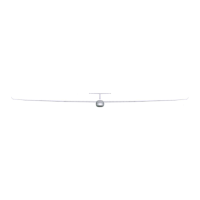DOCUMENT NUMBER:
L500-912.820 ISSUE JUL 20, 2016
AMENDMENT: 00
DATE:
CHAPTERPAGE 39
MAINTENANCE MANUAL STEMME S12
3.3 FLIGHT CONTROL SYSTEM
3.3.1 LONGITUDINAL CONTROL
Both control sticks are coupled by a connection tube. The control movements are transmitted
via push-pull rods to the end of the tail boom and then straight up to the elevator tting. In the
tail boom, the push-pull rod is supported by linear motion ball bearings. Adjustable stops for the
longitudinal control are installed in the middle of the connection tube beneath the right control
system cover in the cockpit. A control tube connection in the tail boom is linked to the spring
trim system.
3.3.2 LONGITUDINAL TRIM
Longitudinal trim is achieved by means of a spring system. The spring forces are adjusted by an
electrical actuator. This actuator is controlled by a switch on the control sticks. The actuator
together with the spring system and the linkage to the elevator control system are situated in
the front part of the tail-boom.
3.3.3 WING FLAP CONTROL SYSTEM
Both ap control levers are coupled by a connection tube beneath the control system cover in
the cockpit. Control inputs are transmitted from this connection tube via push-pull rods to a
“mixing shaft” in the center fuselage. From this “mixing shaft”, the control inputs are transmitted
via bell-crank levers, push-pull rods and quick release couplings to the control rods in the wing.
The control rods in the wing are supported by means of linear motion ball bearings. The control
movement is transmitted to the ap drive ttings via bell-crank levers.
At the mixing unit, the wing ap control is supported by a gas spring against the center steel
frame. This is to minimize loads on the ap lever at appropriate airspeeds related to the respective
ap setting. A viscous damper acting in both directions isolates shock loads from the ap lever
and the ap lock-in. The ap positions are locked at the output lever on the connection tube in
a gate beneath the control system cover.
3.3.4 LATERAL CONTROL
Lateral inputs with the control sticks are transferred via an adjustable push rod to a center
bell-crank lever beneath the connection tube of the longitudinal (elevator) control.
From this bell-crank lever, control inputs are transmitted via push rods to the “mixing shaft”
in center fuselage. Via this “mixing shaft”, bell-crank levers, push-pull rods and quick release
couplings, the control rods in the wing are moved.
Both sides of the wing center section contain a straight-through control rod, supported by several
linear motion ball bearings and equipped with a quick release coupling (L´Hotellier) at the division
of inner and outer wing. From the push-pull rods in the outboard wing, the control movements
are transmitted via two bell-crank levers to the drive ttings of the ailerons.
By means of the “mixing shaft”, the ailerons are moved together with ap position changes
and the aps are moved together with aileron deections (“aperons”). The percentage of co-
movement depends on the position of the control surfaces. Stops for aileron control inputs (ad-
justment screws) are located LH and RH side of the elevator connection tube beneath the covers
of the control system well in the cockpit.

